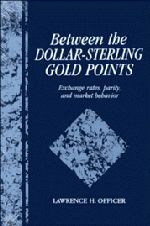Book contents
- Frontmatter
- Contents
- List of figures
- List of tables
- Preface
- List of symbols
- 1 Introduction
- Part I Monetary standards
- Part II Exchange rate
- Part III Gold points
- 8 Gold points: theory and practice
- 9 Gold-point estimates
- Part IV External and internal integration
- Part V Market efficiency
- Part VI Regime efficiency
- Part VII Conclusions
- Notes
- References
- Index
8 - Gold points: theory and practice
Published online by Cambridge University Press: 13 October 2009
- Frontmatter
- Contents
- List of figures
- List of tables
- Preface
- List of symbols
- 1 Introduction
- Part I Monetary standards
- Part II Exchange rate
- Part III Gold points
- 8 Gold points: theory and practice
- 9 Gold-point estimates
- Part IV External and internal integration
- Part V Market efficiency
- Part VI Regime efficiency
- Part VII Conclusions
- Notes
- References
- Index
Summary
Gold-point arbitrage versus gold-effected transfer of funds
Both gold-point arbitrage (GPA) and gold-effected transfer of funds (GTF) involve purchasing specie in one country and transporting it across the ocean to be sold in the other country. Under GPA the indirect foreign-exchange transaction via the medium of gold is combined with a direct foreign-exchange transaction in the opposite direction, resulting in a profit. Under GTF the indirect foreign-exchange transaction via gold substitutes for a direct foreign-exchange transaction in the same direction. The gold and foreign-exchange transactions are complements under GPA, substitutes under GTF. The objective under GPA is to make a sure profit, that under GTF is to transfer funds from one country to the other cheaper than via a direct foreign-exchange transaction.
It is ironic that contemporary accounts of such operations almost always pertain to GTF, whereas modern textbooks deal exclusively with GPA. It is not so much that GTF and GPA are confused in authors' minds; rather, the two operations have somehow become merged as one. Only Einzig (1931, p. 18) distinguishes GTF from GPA:
The terms exchange transaction [GTF] and arbitrage transaction [GPA] are usually used indiscriminately, though there is a considerable difference between them. The object of the exchange transaction is to substitute the shipment of gold for the transfer of funds through the intermediary of the Foreign Exchange Market. The object of the pure arbitrage transaction is the shipment of gold, without any intention of transferring funds, to take advantage of the discrepancy between exchanges and their gold points.
- Type
- Chapter
- Information
- Between the Dollar-Sterling Gold PointsExchange Rates, Parity and Market Behavior, pp. 107 - 116Publisher: Cambridge University PressPrint publication year: 1996



